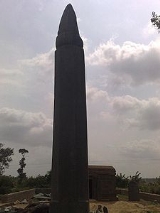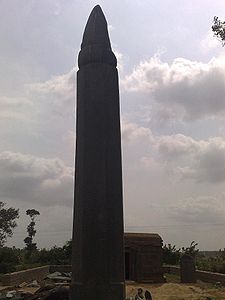
Talagunda
Encyclopedia
Talagunda is a village in the Shikaripura
taluk of Shimoga district
in the state of Karnataka
, India
. Many inscriptions found here have provided insights into the rise of the Kadamba Dynasty.
. An inscription found at Talagunda indicates that 32 Brahmins were relocated from a place called Ahichchatra to Sthanagundur by Mukanna (or Trinetra), thereby creating an agrahara. Mukanna was an ancestor of Mayurasharma
, the founder of the Kadamba Dynasty. Education was imparted at Talagunda for eight centuries and the subjects that were taught included vedas, vedanta
, grammar and philosophy. The Kannada language was taught at primary level and clothing and food was provided to the students and teachers.
God Shiva
) is located in Talagunda. Next to it is located a stone slab containing inscriptions. In front of it is a pillar containing inscriptions in Sanskrit
. The pillar inscriptions were written in the mid 5th century CE during the reign of Śāntivarman (a descendant of Mayurasharma
). The author of this inscription was Kubja, the court-poet of Śāntivarman. He engraved the inscriptions himself to prevent any other engraver from committing mistakes. Kubja, describes these inscriptions as a kavya
Kubja, describes these inscriptions as a kavya
thus:
The inscriptions indicate that Mayurasharma, native of Talagunda, was accomplished in vaidika and went to the Pallava
capital, Kanchipuram
to study scriptures, accompanied by his guru
and grandfather Veerasharama. There, having been humiliated by a Pallava guard (horseman), in a rage Mayurasharma gave up his Brahminic studies and took to the sword to avenge his insult. The inscription vividly describes the event thus:
The inscriptions thus describe Kadambas as Brahmins turned conquerors and praise Brahmins as "Gods on earth, and speakers of Sama, Rig and Yajur Vedas". The Kadamba lineage is described as descending from a three-sage line in the Hariti pravara
and belonging to the Manavya gothra.
Shikaripura
Shikaripura is a town in Shimoga district in the Indian state of Karnataka. It is the headquarters of Shikaripura taluk.-Geography:Shikarpur is located at . It has an average elevation of 603 metres . It lies between plain land of Bayaluseeme and tropical forests of Malenadu.-Demographics:...
taluk of Shimoga district
Shimoga District
Shimoga District is a district in the Karnataka state of India. A major part of Shimoga District lies in the Malnad region of the Western Ghats, a hilly area known for its green forests, plentiful rainfall, and as the source of many of the area's rivers. Shimoga City is the administrative centre...
in the state of Karnataka
Karnataka
Karnataka , the land of the Kannadigas, is a state in South West India. It was created on 1 November 1956, with the passing of the States Reorganisation Act and this day is annually celebrated as Karnataka Rajyotsava...
, India
India
India , officially the Republic of India , is a country in South Asia. It is the seventh-largest country by geographical area, the second-most populous country with over 1.2 billion people, and the most populous democracy in the world...
. Many inscriptions found here have provided insights into the rise of the Kadamba Dynasty.
History
Talagunda was earlier known as Sthanagundur and it was an agrahara (a place of religious learning). This is the earliest known agrahara found in KarnatakaKarnataka
Karnataka , the land of the Kannadigas, is a state in South West India. It was created on 1 November 1956, with the passing of the States Reorganisation Act and this day is annually celebrated as Karnataka Rajyotsava...
. An inscription found at Talagunda indicates that 32 Brahmins were relocated from a place called Ahichchatra to Sthanagundur by Mukanna (or Trinetra), thereby creating an agrahara. Mukanna was an ancestor of Mayurasharma
Mayurasharma
Mayurasharma , a Brahmin scholar and a native of Talagunda , was the founder of the Kadamba Kingdom of Banavasi, the earliest native kingdom to rule over what is today the modern state of Karnataka, India. He took the name of Mayuravarma to emphasise his change from the Brahmin to the Kshatriya...
, the founder of the Kadamba Dynasty. Education was imparted at Talagunda for eight centuries and the subjects that were taught included vedas, vedanta
Vedanta
Vedānta was originally a word used in Hindu philosophy as a synonym for that part of the Veda texts known also as the Upanishads. The name is a morphophonological form of Veda-anta = "Veda-end" = "the appendix to the Vedic hymns." It is also speculated that "Vedānta" means "the purpose or goal...
, grammar and philosophy. The Kannada language was taught at primary level and clothing and food was provided to the students and teachers.
Inscriptions
A temple dedicated to Pranaveshwara (HinduHindu
Hindu refers to an identity associated with the philosophical, religious and cultural systems that are indigenous to the Indian subcontinent. As used in the Constitution of India, the word "Hindu" is also attributed to all persons professing any Indian religion...
God Shiva
Shiva
Shiva is a major Hindu deity, and is the destroyer god or transformer among the Trimurti, the Hindu Trinity of the primary aspects of the divine. God Shiva is a yogi who has notice of everything that happens in the world and is the main aspect of life. Yet one with great power lives a life of a...
) is located in Talagunda. Next to it is located a stone slab containing inscriptions. In front of it is a pillar containing inscriptions in Sanskrit
Sanskrit
Sanskrit , is a historical Indo-Aryan language and the primary liturgical language of Hinduism, Jainism and Buddhism.Buddhism: besides Pali, see Buddhist Hybrid Sanskrit Today, it is listed as one of the 22 scheduled languages of India and is an official language of the state of Uttarakhand...
. The pillar inscriptions were written in the mid 5th century CE during the reign of Śāntivarman (a descendant of Mayurasharma
Mayurasharma
Mayurasharma , a Brahmin scholar and a native of Talagunda , was the founder of the Kadamba Kingdom of Banavasi, the earliest native kingdom to rule over what is today the modern state of Karnataka, India. He took the name of Mayuravarma to emphasise his change from the Brahmin to the Kshatriya...
). The author of this inscription was Kubja, the court-poet of Śāntivarman. He engraved the inscriptions himself to prevent any other engraver from committing mistakes.

Kavya
Kavya refers to the Sanskrit literary style used by Indian court poets flourishing from the first half of the seventh century AD. This literary style is characterised by abundant usage of figures of speech, metaphors, similes, and hyperbole to create its emotional effects...
thus:
The inscriptions indicate that Mayurasharma, native of Talagunda, was accomplished in vaidika and went to the Pallava
Pallava
The Pallava dynasty was a Tamil dynasty which ruled the northern Tamil Nadu region and the southern Andhra Pradesh region with their capital at Kanchipuram...
capital, Kanchipuram
Kanchipuram
Kanchipuram, or Kanchi, is a temple city and a municipality in Kanchipuram district in the Indian state of Tamil Nadu. It is a temple town and the headquarters of Kanchipuram district...
to study scriptures, accompanied by his guru
Guru
A guru is one who is regarded as having great knowledge, wisdom, and authority in a certain area, and who uses it to guide others . Other forms of manifestation of this principle can include parents, school teachers, non-human objects and even one's own intellectual discipline, if the...
and grandfather Veerasharama. There, having been humiliated by a Pallava guard (horseman), in a rage Mayurasharma gave up his Brahminic studies and took to the sword to avenge his insult. The inscription vividly describes the event thus:
The inscriptions thus describe Kadambas as Brahmins turned conquerors and praise Brahmins as "Gods on earth, and speakers of Sama, Rig and Yajur Vedas". The Kadamba lineage is described as descending from a three-sage line in the Hariti pravara
Pravaras
Literally, Pravara means the most excellent . Pravara is the number of the most excellent rishis who belonged to that particular gotra to which the wearer of sacred thread belongs. Gotra is the name of the founding father...
and belonging to the Manavya gothra.

